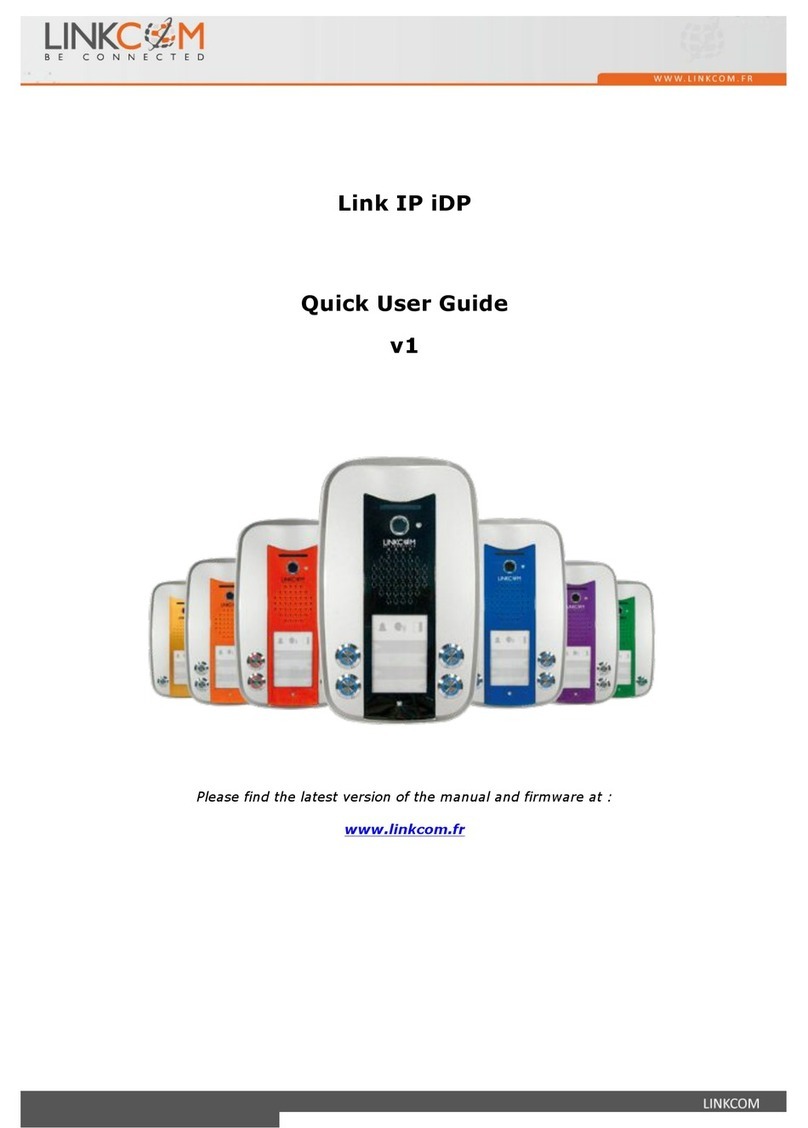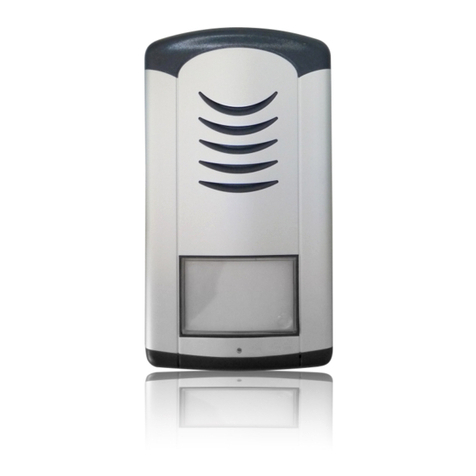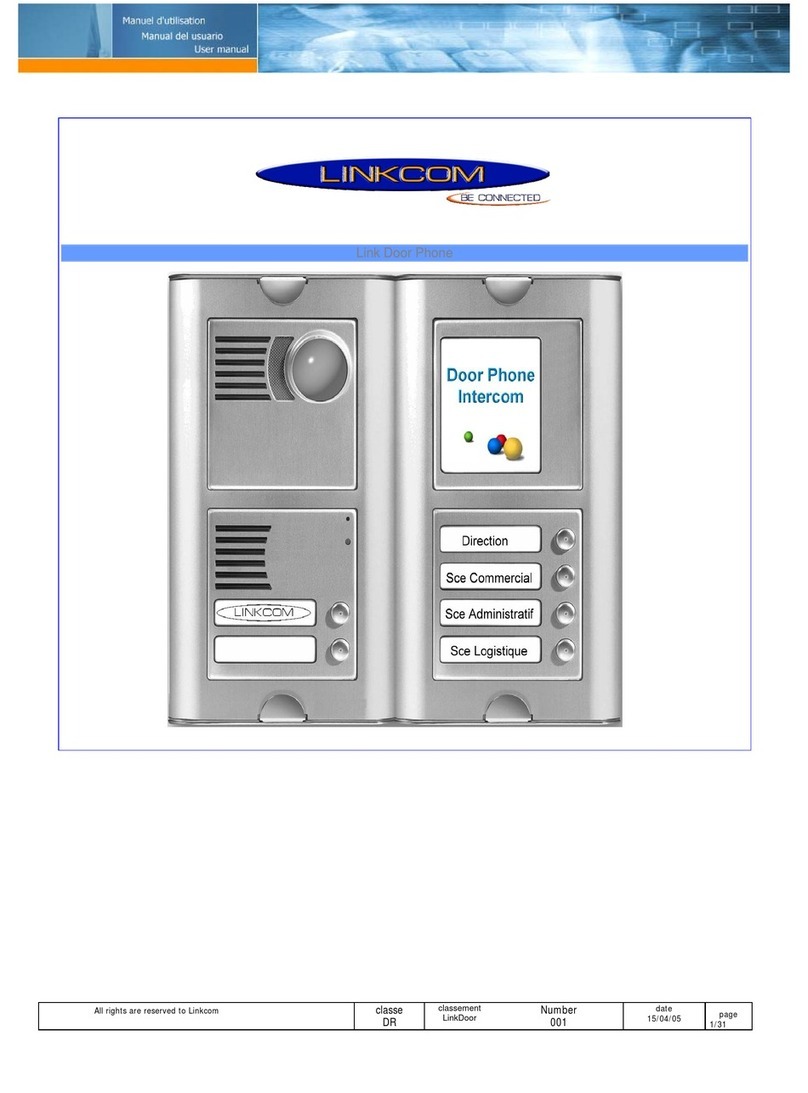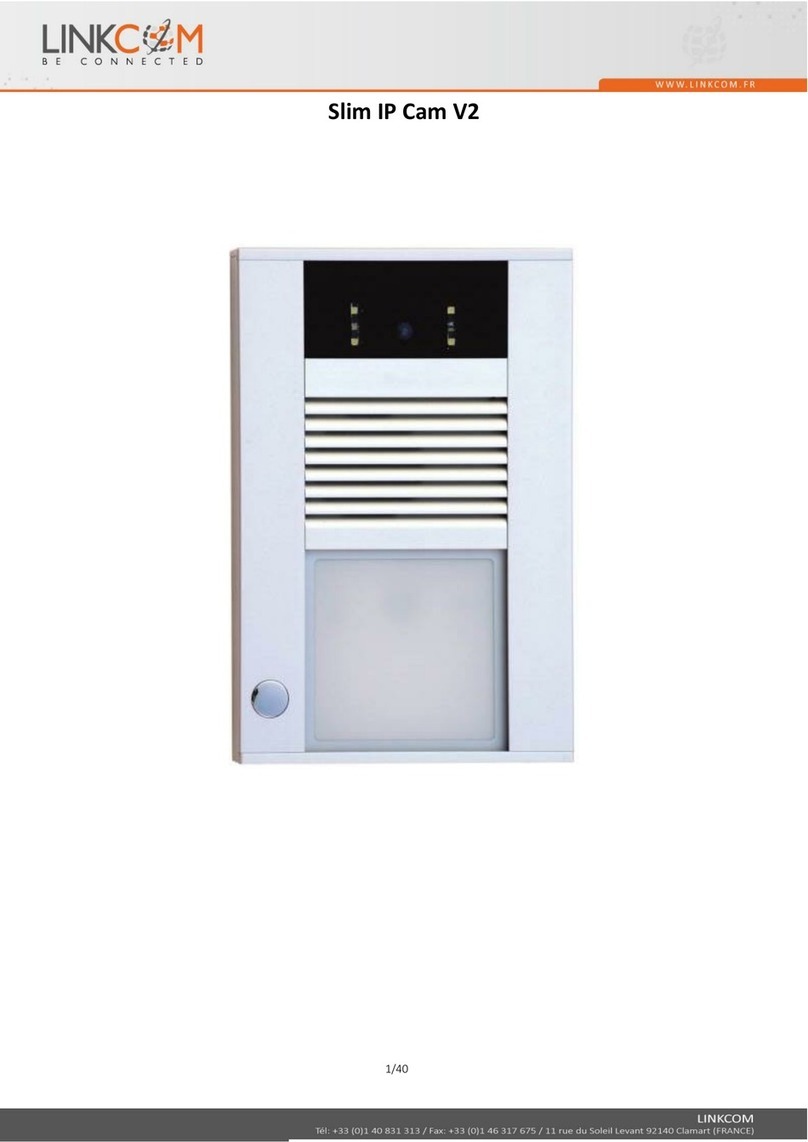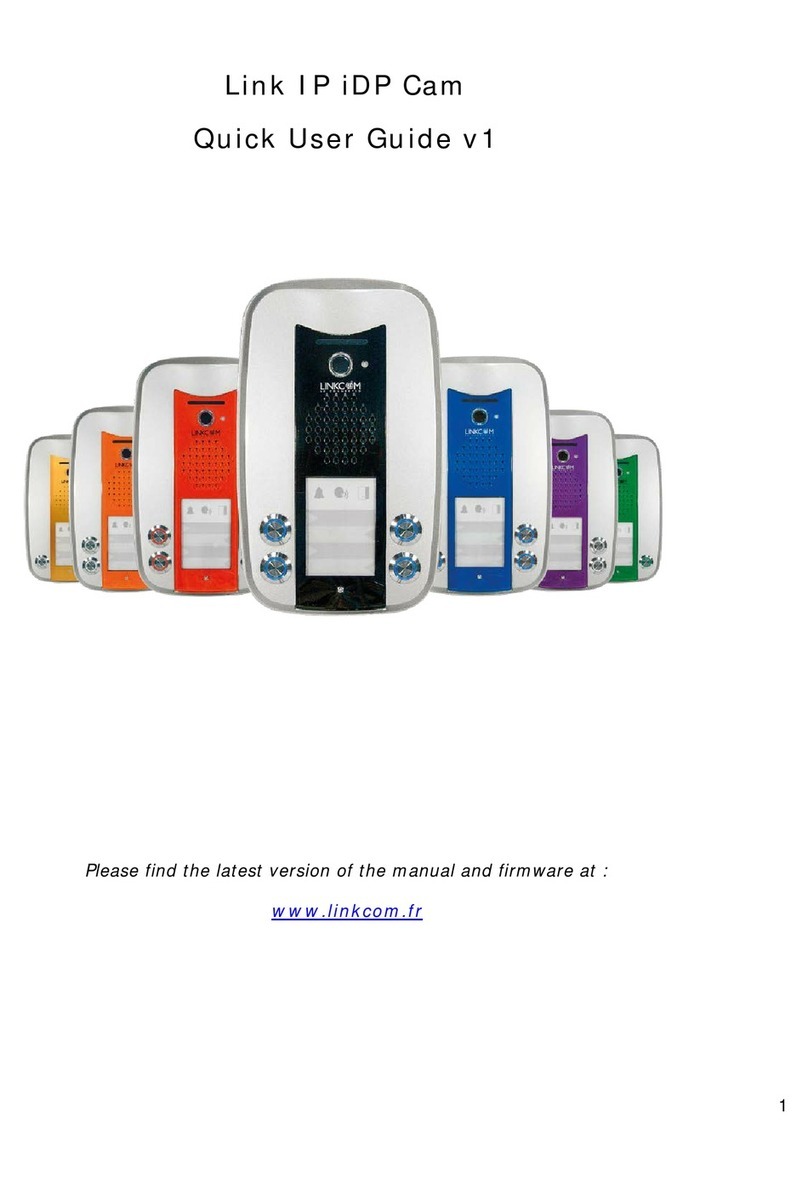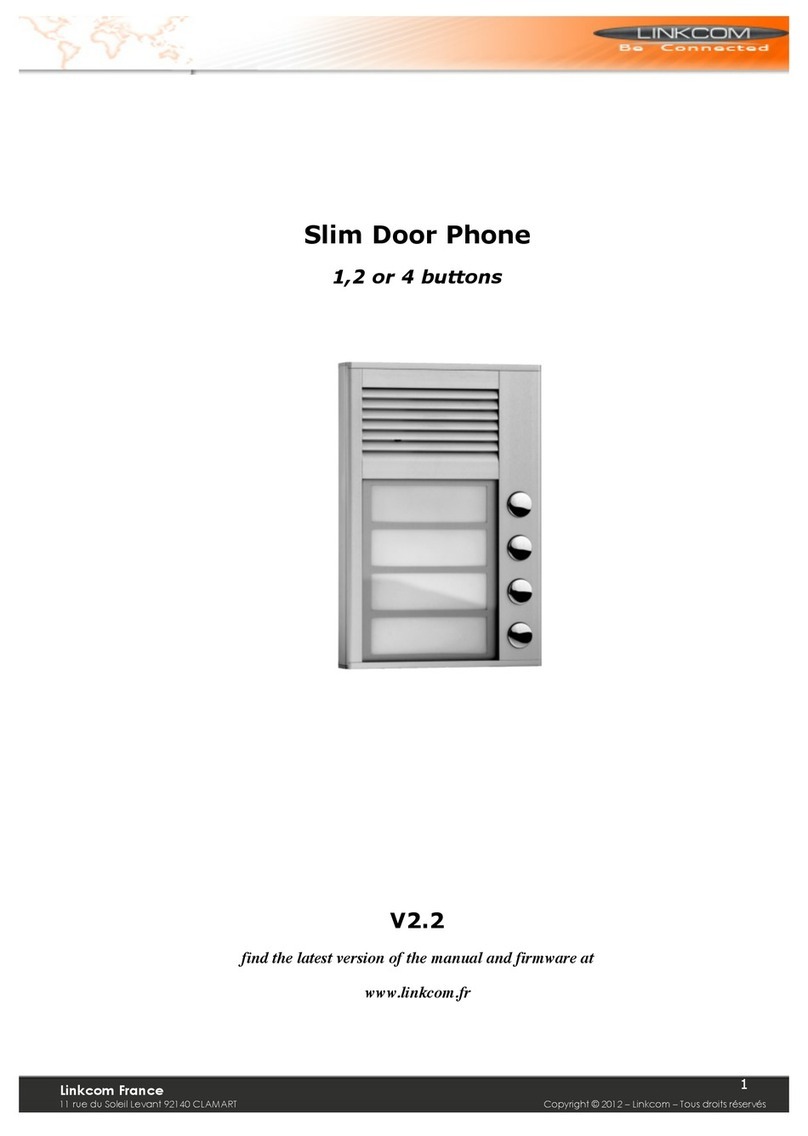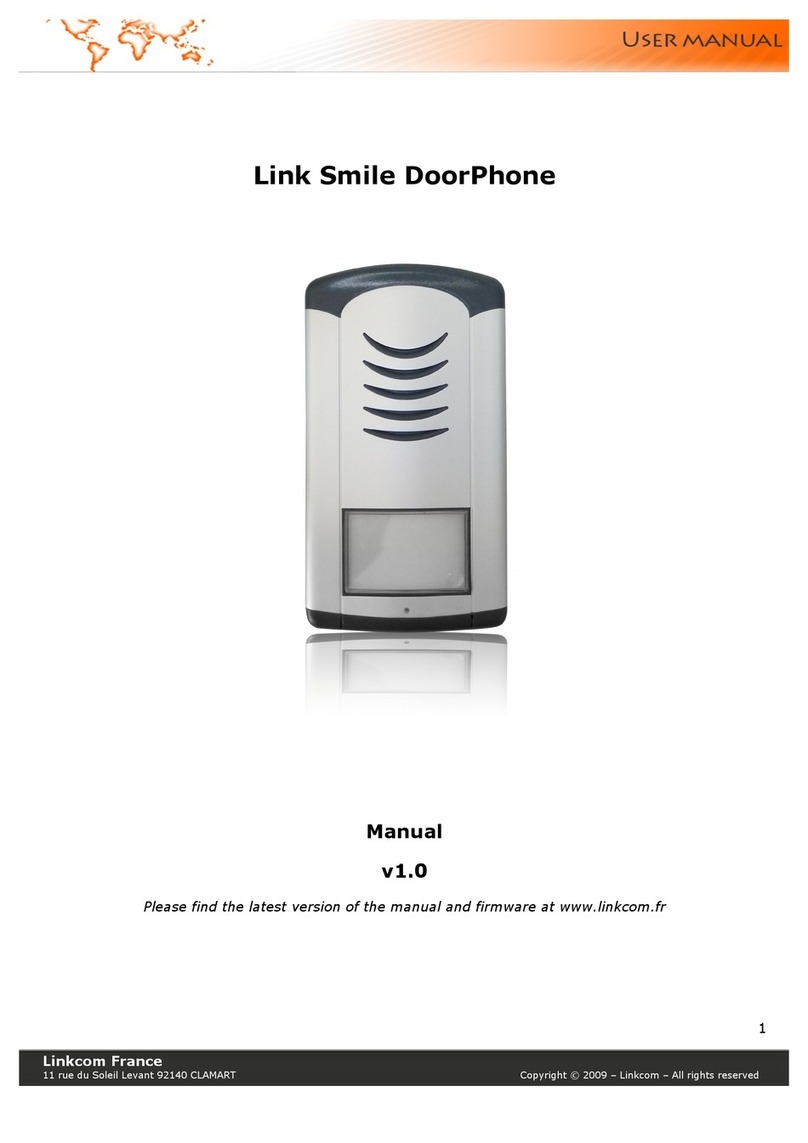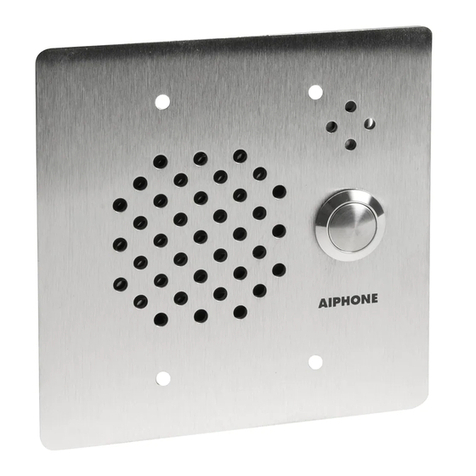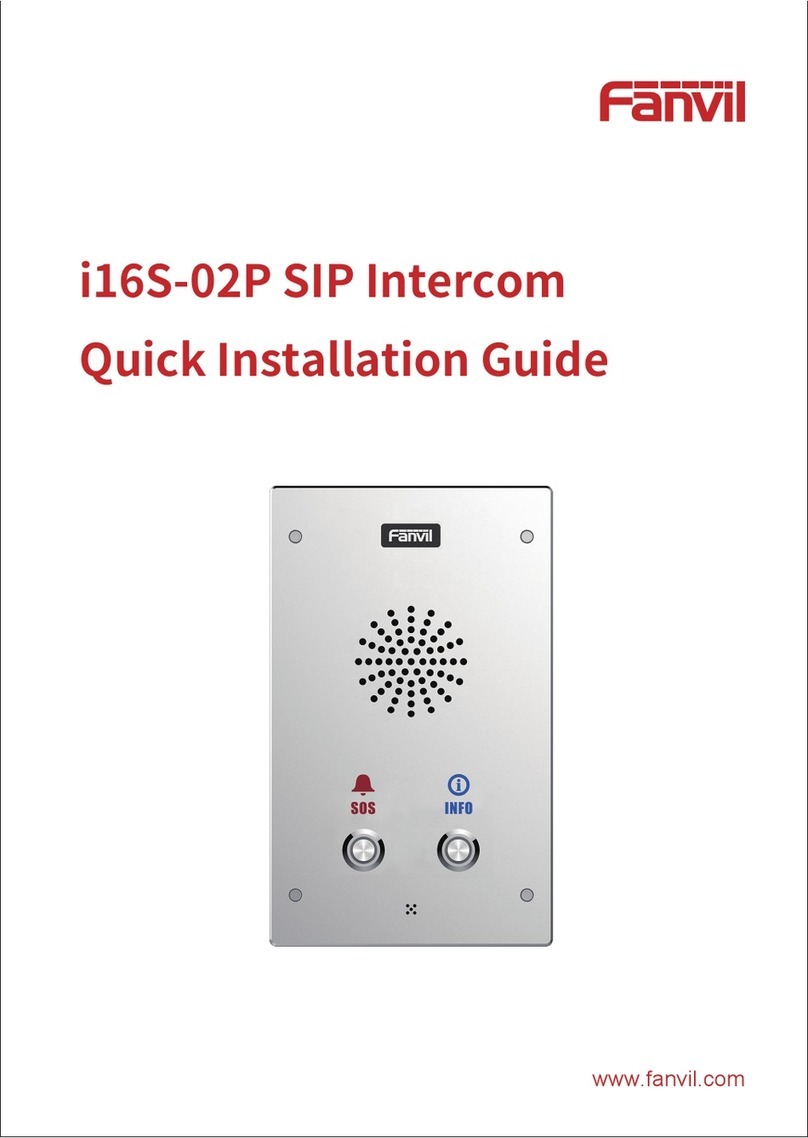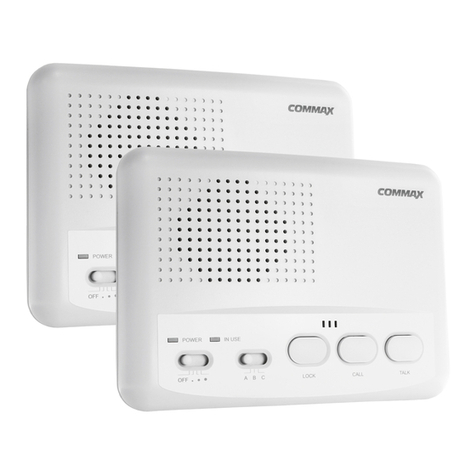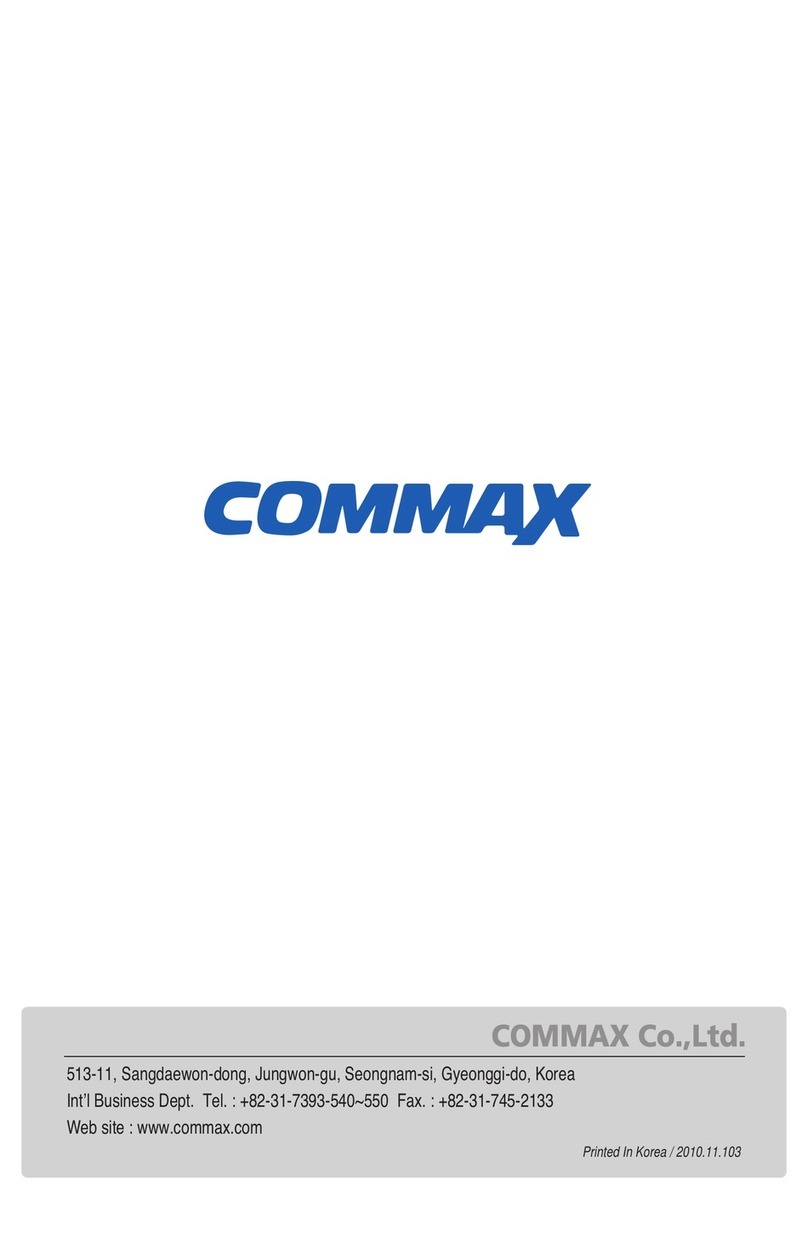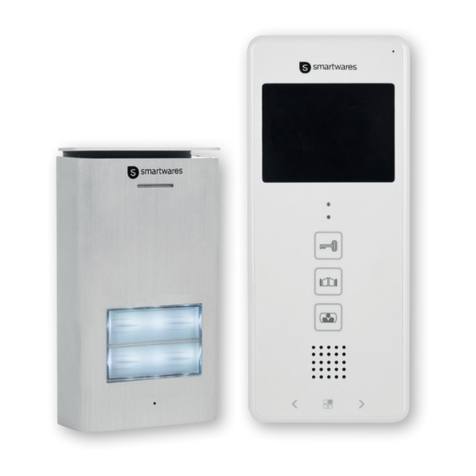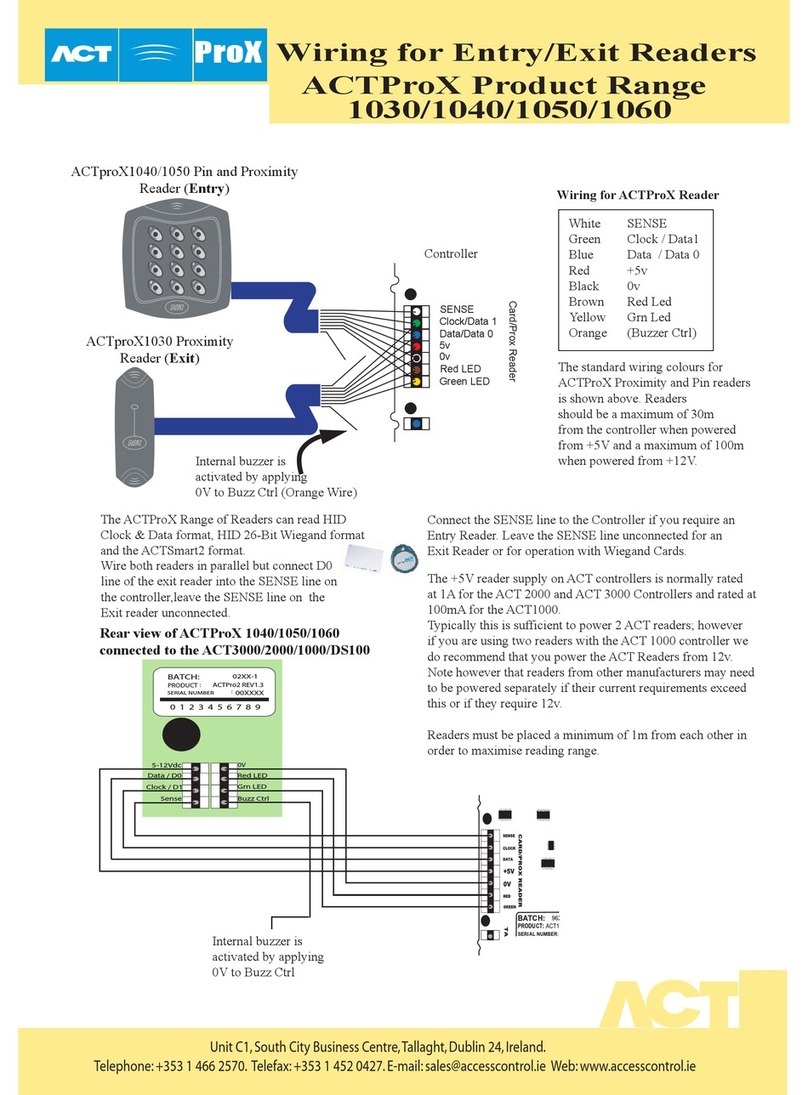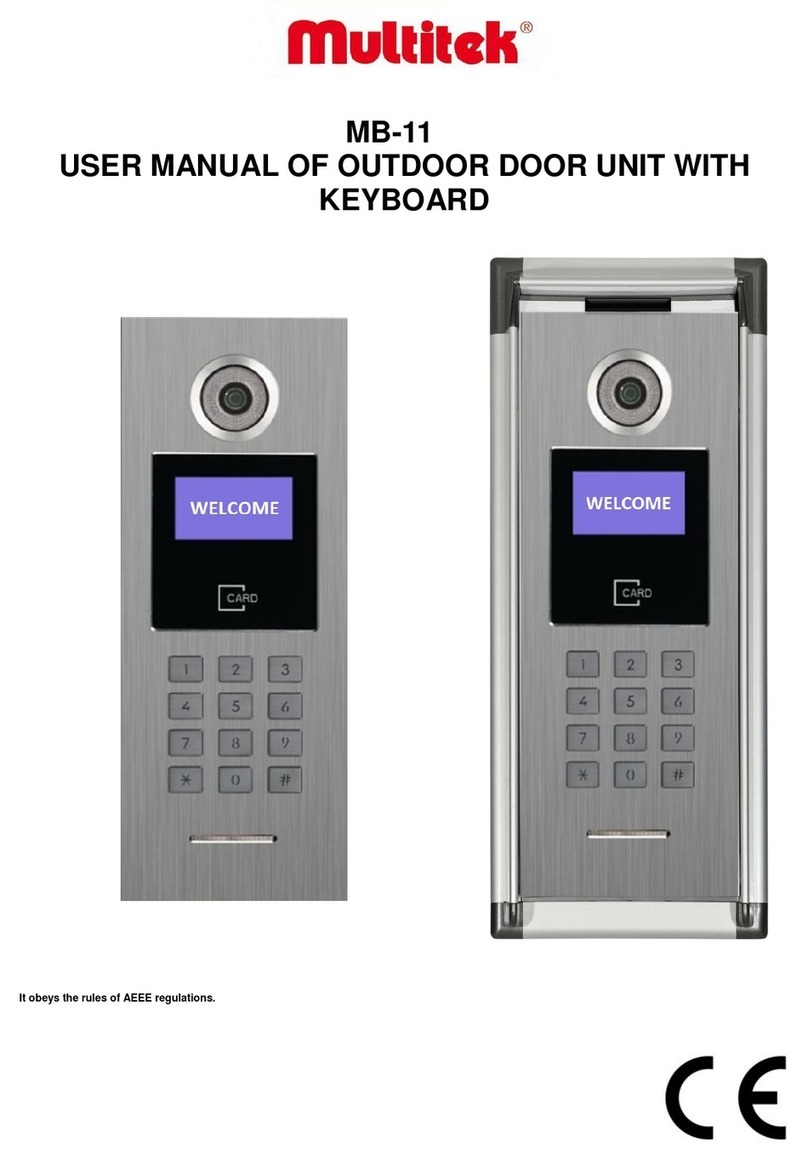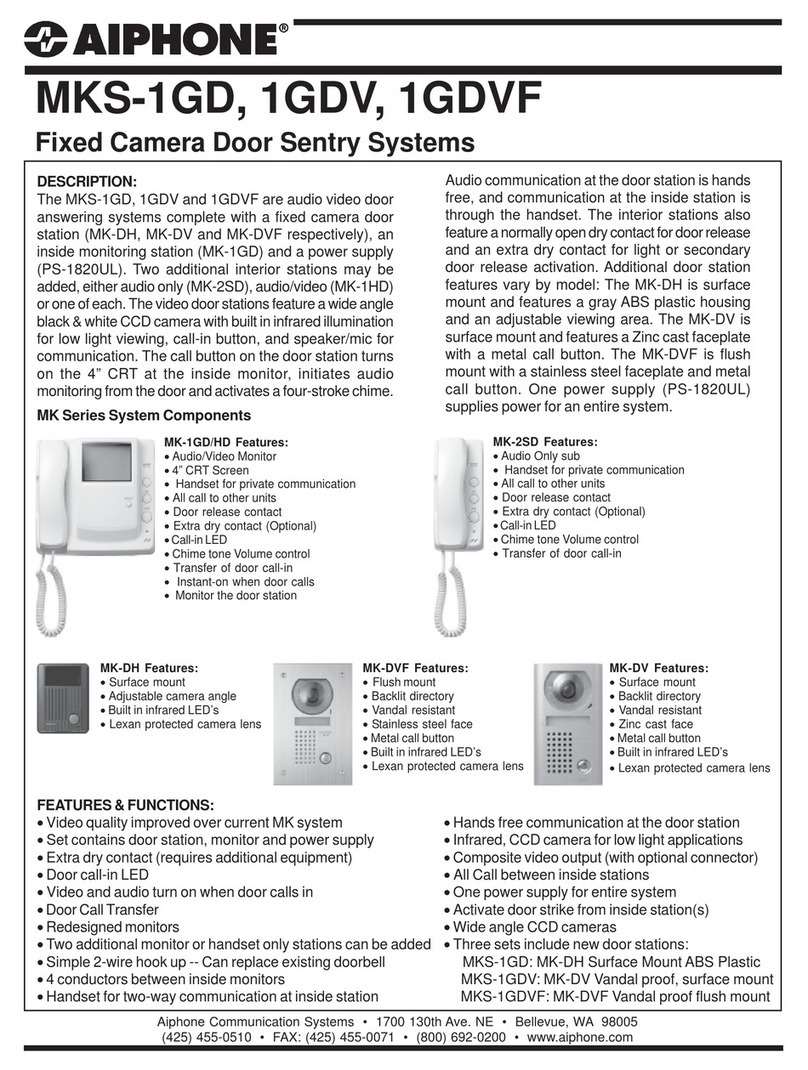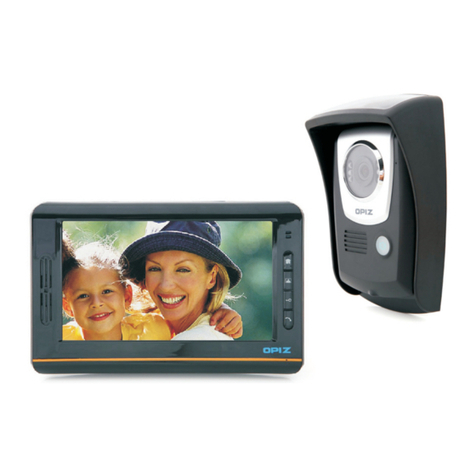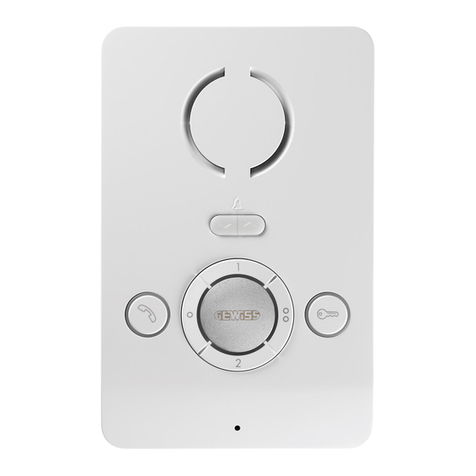Linkcom Link Ana iDP User manual

1
Link Ana iDP
Manual v1.0
Please find the latest version of the manual and firmware at www.linkcom.fr

2
Table of Contents
1. Basic Description...................................................................................................................................................... 3
1.1. PCB Schematics....................................................................................................................... Erreur ! Signet non défini.
2. Physical install .......................................................................................................................................................... 4
2.1. Opening the door phone ...................................................................................................................................................4
2.2. Dismounting of nameplate...............................................................................................................................................4
3. Wall mounting ........................................................................................................................................................... 4
3.1. Dimension ..............................................................................................................................................................................4
3.2. Surface mounting.................................................................................................................................................................5
3.3. Flush mounting.....................................................................................................................................................................5
3.4 Connection ..............................................................................................................................................................................6
4. Link Ana iDP Service ............................................................................................................................................... 7
4.1. Signaling overview..............................................................................................................................................................7
4.2. Visitor at the door ...............................................................................................................................................................8
4.3. Relays mode control ...........................................................................................................................................................8
4.4. Telephone Caller............................................................................................................................................................... 10
4.4.1. Outgoing call ................................................................................................................................................................... 10
4.4.2. Incoming call...................................................................................................................................................................10
5. Parameter programming.....................................................................................................................................10
5.1 Programming from a telephone by DTMF ................................................................................................................10
5.1.1 Parameter programming ............................................................................................................................................10
5.2 PC programming – “Link Analog Manager” software ........................................................................................... 11
6. Parameter description ........................................................................................................................................12
6.1. Direct numbers dial – memories.................................................................................................................................12
6.2. Relay...................................................................................................................................................................................... 12
6.3. Basic parameters .............................................................................................................................................................. 15
6.4. Time parameters .............................................................................................................................................................. 16
6.5. System parameters .......................................................................................................................................................... 19
6.6. HandsFree Parameteres setting..................................................................................................................................20
6.7. Time programm – automatic DAY/NIGHT switching........................................................................................... 22
6.8. Default setting and erasing ...........................................................................................................................................23
6.9. Exit programming ............................................................................................................................................................ 23
7. Technical parameters ...........................................................................................................................................24

p.3 | 23
1. Basic Description
DIP switch description
1 = Service, usage – when programming password is forgotten. Incoming call is going directly to
programming mode where you can set new password.
2 = Heating – switch ON integrated heating of mother board to increase resistance against
condensation water during changes of temperature
3 = external power supply
4 = external power supply – switching 3 and 4 simultaneously. The powering is used from screw 12V
due following reasons:
- Using relay mode 7 or 8 – permanent switching ON/OFF is possible only with external power
supply. Don’t forget setup Parameter 64.
- Connection of door intercom to certain type of PBX which has problems with current consumption
on its extensions during start (Siemens).
5 = Camera lighting up (switch ON/OFF lighting of space before camera via infra LED)
6 = Cards lighting (switch ON/OFF Leds backlighting for cards beside button)
7 = Activate permanent camera operation. In default camera is active only when door intercom is
active.
8 = Allows connect 75ohm to camera output - impedance
1.1. PCB Schematics
USB cable
connector
Handicapped
norm LED
Mini Dip Switch
Button 2
Button1
Button 3
Button 4
Out button
Relay 2
Relay 1
GND
Analog line
Speaker
backlight label LED
12V Power supply

p.4 | 23
Handicapped norm LED : indicate the status of doorphone :
•Green LED : Ringing.
•Blue LED : In call
•Red LED : Door opening
2. Physical install
2.1. Opening the door phone
Using the tool provided, unscrew the screw, as shown below and remove the cover:
2.2. Dismounting of nameplate
Remove the 4 screws of the transparent protection. Make the appropriate changes on the nameplate and
mount the protection using 4 screws.
3. Wall mounting
3.1. Dimension
Height: 182mm
Width: 104mm
Depth:: 22mm

p.5 | 23
3.2. Surface mounting
Using 3 screws and plugs, fix the doorphone to the wall:
3.3. Flush mounting
The dimensions of the flush part are:
•Height: 182mm
•Width: 104mm
•Depth: 22mm
Using 3 screws and plugs, fix the doorphone to the wall:

p.6 | 23
3.4 Connection
Line :
The basic functionality of intercom (voice communication) needs connection of telephone line only. When
you connect the line, the Link Ana iDP announces by sound signal.
We not recommend connecting the Link Ana iDP in parallel with other analog phone.
Attention: The line is necessary to program the Link Ana iDP by the software.
12V Power supply:
The power supply might be AC and also DC, not depends on polarity. For 12V, the max consumption is
250mA. Power supply might be used also for electrical lock powering. Then we recommend power supply
12V/1A.
Attention: The power supply is necessary for the correct operation of the relay.
Relays:
Relays have many possibilities in practice usage. 12V power supply must be connected for correct
operation. The intercom unit has galvanically isolated all-important parts. Telephone line is isolated from
power supply and relays contacts are also galvanically isolated from other intercom electronic parts.
In any case must not be activated directly main voltage 120V or 230V !!! When you need
control main devices please use contactors (power relays) as it is on example
Relays connection examples are mentioned on following page. It is not all of them but give you an
idea how should be connected individual circuits (red rings with numbers = example numbers).
1. Basic connection - 2 electrical locks and possibility independently control two doors. (Relay mode 1
and 2 m=1) or progressive door opening (relay mode 2 m=5).
2. Two power supply – possibility to use independently two power supply One for Link Ana iDP and
second for electrical locks. Second electrical lock is connected inversely (fire emergency exit).
3. Combination of doors with electrical lock and sliding gate at fencing.
4. Extending of previous example (3) about second doors with progressive opening (this feature is setup
in Time Relay - optional module)
5. Combination of electrical lock and additional ring. Relay of additional ring might be in mode m=4
(from each button is activated for preprogrammed time) or in mode m=6 (it is activated from one
preset up button for preprogrammed time)
6. Lighting activation m=3 (for example: way to building) and control of for example: heating up
DAY/NIGHT mode m=8 External power supply required (DIP 3 and 4). Further is necessary use
contactor (Link Ana iDP must not activate 230V!).
Code relay (COSW)
For the first switch is available function code relay (COSW CodeSwitch). It serves primarily to
secure transmission of information by switching the electric lock. When using this function is not possible
connecting or disconnecting the voltage at the terminals to lock this lock activated. Activation is
performed only when positive result compared serial information transmitted between Link Ana iDP and
the board code relay
Link Ana iDP is set in several codes to activate the relay code. Relay can be activated codes for one
or two impulses can differentiate activated from the phone (DTMF) or from keys (keyboard). The last
option is the activation code in another mode switch than the lock.
The code information is 8 bits, but the code is 4 bits with security 4 bits which is total of 8 bits.
Practically, this is performed so that after activation the switch is first transmits the serial code, and if
they agree, so code relay connects the electric lock.
The code relays can be connected in parallel to increase the number of switches, but can never combine
connections electric lock and the code relay parallel!

p.7 | 23
4. Link Ana iDP Service
4.1. Signaling overview
The Link Ana iDP signaling acoustically stages which are happening during operation. Samples of
acoustical sounds you can play in Link Ana Manager.
Stage Tones
Tone
frequency
Line pick up (OFF HOOK) type 1 –▄■▄■▀– 980-1333-1650
Line hang up (ON HOOK) type1 –▀■▄■▄– 1650-1333-980
Line pick up (OFF HOOK) type 2 –▄■▀–
800-1067-1200-
1333
Line hang up (ON HOOK) type2 –▀■▄–
1333-1200-1067-
800
Command confirmation by phone ––█–– 800
Alerting (knocking) into call ─┴─┴─

p.8 | 23
Call ending alert –■–■–■– 1333
Relay activation signal ─▒▒▒▒▒▒─ Modulated
Programming enter by phone –▄■▀– 980-1067-1180
Programming by phone ––▓–▓––––– Modulated
Parameter confirmation ––█–– 800
Programming enter by PC –▄■▀– 980-1067-1180
Line connection (Reset) –■–▄–■– 1850-1067-1850
Error (generally all incorrect) –■–■–■–■–■–■– 800
Memory empty (no number
programmed)
–▄■▄■▄■▄■– 1300-2100
For the problems identification is very good when you know the tones. It helps you monitor how door
intercom works and where from comes the problem. The signaling might be switch of in a few levels
(Parameters 61,62,63 and 65).
4.2. Visitor at the door
When the visitor finds the desired name and push it, the Link Ana iDP pick up the line and play the tone
line pick up (when is not switch off by parameter 62) and calls the phone number saved under the
button (parameter 1). On the Link Ana iDP speaker you hear ringing tone and the destination phone
ringing.
As soon as the destination phone pick up, you can talk to visitor at the door.
When is electrical lock is connected to the Link Ana iDP, you can open the door for visitor by dial DTMF
code on the destination phone.
When the destination phone hang-up the line then the Link Ana iDP hangs up after busy tone detection.
When the call duration is longer then setup limit (parameter 52) 10 sec before hang up, the Link Ana
iDP sends a alerting tone of call ending, dial * or # (parameter 42) to prolong the call.
The dialed number is dictated by the chosen mode, which is set in the unit (parameter 47):
•Day/Night mode: If the unit is in Day mode, it will always dial the number set in parameter 1,
In Night mode, it will always dial the number set in parameter 2. The mode switchover is set in
parameters 45,46.
•2 groups numbers mode: On the first press the number set in parameter 1 will be dialed. When
the same button is pushed or 10 seconds after dial busy tone is detected, or setup number of
rings is out (parameter 56), the unit will select the number from the second group (parameter 2).
The next press of the same button again selects the number from the first group, etc.…
When visitor push the button after line is picked up the Link Ana iDP hangs up for time setup by
parameter 54 and then picks up the line and dial new number. The dialing number is either by tone dial
(DTMF) or pulse dial up setting by parameter 41. There is one more option: the line hangs up by again
pushing of same button (parameter 4*).
4.3. Relays mode control
You can control relay(s) by door intercom buttons (code lock). When visitor push buttons in order which
match to setup code (Parameter 32-34) and time between each button press is not longer than setup by
(Parameter 53) then door intercom picks up and activate appropriate relay (when relay setup is mode
m=1 or m=5) for time setup by Parameter 37 eventually.39,30. Then hangs up.
The relay (up control code) can activate one pulse or two pulses with time between each pulse setup by
Parameter 30 :

p.9 | 23
mode m = 1 (Parameter 3111 and 3121)
Action
Note
Parameter
Relay
Evaluation of correct
external code from
buttons
3211-3215
According settings
DAY/NIGHT
3311-3315
3411-3415
3221-3225
According settings
DAY/NIGHT
3321-3325
3421-3425
321*
According settings
DAY/NIGHT
331*
341*
322*
According settings
DAY/NIGHT
332*
342*
Internal code from
phone You can dial 1 or 2
numbers of code
2digits code is default
You can shorter it by
using * on first digit
of code during
programming
351
352
361
362
Mode m = 5 (Parameter 3125)
Action
Note
Parameter
Relay
Evaluation of correct
external code from
buttons
3211-3215
According settings
DAY/NIGHT
3311-3315
3411-3415
3221-3225
According settings
DAY/NIGHT
3321-3325
3421-3425
321*
According settings
DAY/NIGHT
331*
341*
322*
According settings
DAY/NIGHT
332*
342*
Internal code from
phone You can dial 1 or 2
numbers of code
2digits code is default
You can shorter it by
using * on first digit
of code during
programming
351
352
361
362
mode m = 4
Action
Note
Parameter
Relay
Button push
Any button different
from 311* or 312*
3114
3124
Button setup by 311*
or 312*
3114
3124
Mode m = 6
Action
Note
Parameter
Relay
Button push
Any button different
from 311* or 312*
3116
-
3126
-
Button setup by 311*
or 312*
3116
3126
t1 – time activation 1 of relay (Parameter 371)
t2 – time between pulses 1 of relay (Parameter 301)
t3 – time between activation 1 and 2 relay (Parameter 39)

p.10 | 23
t4 – time activation 2 of relay (Parameter 372)
t5 – time between pulses 1 of relay (Parameter 302)
4.4. Telephone Caller
A Telephone Caller is a person that is in phone connection with Link Ana iDP.
4.4.1. Outgoing call
An “outgoing” call is a call from the unit (i.e. when a visitor presses a button). Once the visitor has
pressed a button a telephone will ring. On answering the telephone, you will be able to converse with the
visitor. 10 seconds before the maximum call duration (parameter 52) the unit will emit a tone to warn
that the call will end. Pressing the key as set in parameter 42 may extend the call. A code may be dialed
to close the relay (parameter 35), releasing the lock. Hanging up the telephone will end the call, as will
the busy tone from the PBX.
4.4.2. Incoming call
An incoming call is a call to the unit. After dialing the PBX extension number to which the unit is
connected, the unit will ring for the set number of rings (parameter 51), the unit will lift up and it is
possible to speak. The possibilities are the same as with outgoing call (Chapter 3.3.1). It is also possible
to switch between Day and Night service.
•If, within the first 10 seconds, the service password is entered (#0000), the unit will switch to
programming mode and voice communication will cease.
•Second exception is when DIP1 is switch to position ("SERVIS"). Then you enter in programming
mode directly without dialing service password.
•During an incoming call it is possible to restrict relay control. This can be useful in some special
applications.
5. Parameter programming
5.1 Programming from a phone by DTMF
The Link Ana iDP may be set to programming mode in two ways:
•by password : dial the unit‘s number (either extension number, if connected to a PBX or
telephone number, if connected to a PSTN line). The unit will answer (you will hear the Pick up
line tone – see Chapter 3.1). Within 10 seconds dial # xxxx, where xxxx is the password for
entry to programming and, if OK, the registration tone for programming mode will sound, and
afterwards the Programming tone is heard.
•By "SERVICE" switch – dial the unit in the same way as in 1, but when the SERVICE switch is
connected, the unit will automatically enter programming mode. You will hear the call connection
confirmation tone; the confirmation tone for programming mode and afterwards the
Programming tone is heard.
5.1.1 Parameter programming
The initial state for programming is signaled by the programming confirmation tone. The unit will always
revert to this state after 5 seconds of inactivity, even if you have started to program a parameter.
When programming, there are two types of parameters. The majority are parameters with a fixed
length. The parameter is always saved immediately and is confirmed by Parameter Confirmation tone.
Parameters with variable length (parameters 1,2,32,33,34) are saved after the inactivity period
expires (5 sec). However, a variable length parameter will be saved immediately when maximum

p.11 | 23
permitted number of digits is reached. For parameters 1 and 2 the maximum number of digits is 16, and
for parameters 32,33,34 it is 6.
If, during programming, you enter a number that is not allowable, then the unit immediately emits an
error tone. The parameter will not be recorded or changed, and the unit will return to its initial
programming state and it will be possible to repeat the parameter setting or program another
parameter.
The unit stays inactive in programming mode for 34 seconds and will then automatically hang up. Every
time a DTMF tone is dialed, this period is reset. Alternatively, parameter 9 may also be selected to end
programming mode.
To program a parameter, enter the parameter number followed by the value you wish to set. The unit
will either respond with the Parameter Confirmation Tone, or one of the Error Tones.
•Note 1. if you wish to maintain the connection in programming mode (i.e. extend the 34 seconds
period) then it is necessary to occasionally press a key (e.g. *, # or 7). The unit will respond with
an error tone but the connection will be kept alive.
•Note 2. The # sign is not used in the values for parameters 32,33 and 34, and can be used to
immediately save the parameter.
•Note 3. If you hang up the phone during programming mode without press 9, the doorphone will
stay in programming mode during 30 seconds.
5.2 PC programming – “Link Analog Manager” software
To setup the unit from a PC you will require a special USB tool cable, available separately, and must first
install the USB driver and software. Refer to the www.linkcom.fr for more details. The unit must also be
connected to the telephone line.
Procedure:
•Connect the Link Ana iDP to the phone line
•Connect the unit to the PC with the special USB cable.
•Run the software program. The unit will enter PC programming mode and emit the Enter
programming tone If connection is lost, it is necessary to disconnect the USB cable from unit
and connect it again. The unit will answer and, providing the program is running, it will confirm its
entry into programming mode again.
When the connection is correct, you can the firmware version of Link Ana iDP (visible in bar).

p.12 | 23
6. Parameter description
6.1. Direct numbers dial – memories
Parameter
Value Description Default
1 tt nn…
nn=destination Number. tt=button
number
-
tt – button number (memory), always has 2 digits [01-04]
nn – telephone number up to 24 digits to be stored. Refer to the table for other choices. The num
stored in parameter 1 is the number for the first group or the number for Day mode.
Parameter
Value Description Default
2 tt nn…
nn=destination Number. tt=button
number (01)
-
tt – button number (memory), always has 2 digits [01-04]
nn– phone number up 24 digits to be stored. Refer to the table for other
choices.
Numbers saved in parameter 2 are numbers of second group, or numbers of
Night mode.
Default settings doesn’t erase as same as changed those saved numbers.
Note: The switchover to Day/Night mode remains set in the unit even after line disconnection.
For the Link Ana iDP, tt is always 01
6.2. Relay
Parameter Value Description Default
31 r m Relay mode 11
r – relay number [1-2]
m– relay mode [1-8 for r=1 is not mode m=5]
Modes m=1,4,5,6 please see “4.3. Relays mode control.”
m=1 mode relay – activated by command (internal code) or password (external code) 1 pulse for time
t1/t4 (using for electrical locks) or 2 pulses when is activated for time t1/t4, open for time t2/t5
and close for time t1/t4 (sliding door opening)
m=2 closed for time of line OFF HOOK (camera) – close when door intercom picks up and open by
hanging up
m=3 closed for time of line OFF HOOK and more for time t1/t4 after hang up (lighting) – closed when
door intercom picks up and stays closed for time t1/t4 after door intercom hangs up (for this time
line is busy, at version /C and C is after switching DIP 3,4 and settings Parameter 64 for time t1/t4
line hanged up)
m=4mode button – closed when any button is pushed and open after time t1/t4 (usage for example:
connection external bell)
m=5mode progressive opening – you can setup into this mode relay 2 only because relay 1 will be
setup automatically into mode m=1. By command (internal code) or password (external code) is
activated relay 1 for time t1, then is running time t3 before closing relay 2. Then is relay 2
activated for time t4 and then door intercom hangs up. When dialled command or password match
to 2 pulses then in sequence will appear two pulses separated by time t2/t5.
Description
Dial
0 - 9
0 - 9
#
#
*
**
Flash
* #
Pause
* 0
Description
Dial
0 - 9
0 - 9
#
#
*
**
Flash
* #
Pause
* 0

p.13 | 23
Note. The command or password for relay 1 start whole sequence. When you use command or password
for relay 2 then you control relay 2 only the same like in mode m=1.
m=6closed up pushed button (setup in Parameter 31r*). Due this you can select one button for every
relay its pushing activate appropriate relay for time t1/t4. This mode serves as substitution of ring
bell connected to Link Ana iDP system.
m=7permanent closing / opening –if switching (DIP 3,4)+par.64. By command for pulse 1 is closed
and for pulses2 is opened. This stage stays in door intercom even after power/line disconnection.
This mode you can use for potting, glasshouse opening, heating activation etc..
m=8activated up DAY/NIGHT mode settings - if switching (DIP 3,4)+par.64. Version allows copying
manual DAY/NIGHT switching only. The Link Ana iDP allows copying setting from week table
switching time (when is activated - Parameter 084) and then you can use for example for heating
control etc…
Paramet
er
Value Description Default
31 r* tt
Button tt start relay closing r in mode
m=6
(01-99)
01
r – relay number [1-2]
tt – button number (memory), always has 2 digits [01-99]
This Parameter is for relay mode m=6 only. Value of tt designate from which button start closing for time
t1/t4 of relay r.
Paramet
er
Value Description Default
32 rp hh...
In mode DAY + NIGHT password
hh... for relay r, in order p=1-5, for 1
pulse and p=* for 2 pulses
(00-999999)
-
33 rp hh...
In mode DAY password hh... for
relay r, in order p=1-5, for 1 pulse
and p=* for 2 pulses
(00-999999)
-
34 rp hh...
In mode NIGHT password hh... for
relay r, in order p=1-5, for 1 pulse
and p=*
for 2 pulses
(00-999999)
-
r – relay number [1-2]
p– order [1 - 5] for 1 pulse. 5 passwords (external codes) from door intercom buttons (external
code of code lock)
p– order = *, then you can insert just one code (external code) for closing by 2 pulses
hh... – password (external code) for relay closing from buttons [2 to 6 digits]. 1 - 10 are programmable
as numbers 1-0.
Totally 3 x 12 passwords. Controlled by settings DAY/NIGHT. Combination is inserting by door
intercom buttons.Relay closing is influenced by setup relay mode and switching DAY/NIGHT. When is
a setup mode 2 group of numbers the door intercom is permanently in mode DAY.
You have to keep certain rules for password dialing:
First button of password select from at least used button for direct dialling (-prolong dial time)
Caution on numbers identity of password. When one password includes other, for example:
password for relay1 is 1234 and for relay 2 12345, then always after pushing button 4 relay 1
will be activated and relay 2 wont be never activated. When you select password for relay 2 234,
then after button 4 pushing both relays will be activated.
Note1. Switching to DAY/NIGHT mode stays setup in door intercom even after power (line)
disconnection. At version (C), when is activated, then DAY/NIGHT switching is done up time and week
table.
Note2. when you insert Parameters 32, 33, 34 do not use character # and * because you cant select
them from button panel. Number 0 represents button 10.

p.14 | 23
Parameter Value Description Default
35 r aa
First code aa from phone for relay
activating r (00-99,*0-*9)
1 55
36 r cc
Second code aa from phone for relay
activation r (00-99,*0-*9)
1 50
r – relay number [1-2]
aa – command (internal code) from phone for relay activation [2 digits] /1
For both relays you can setup the same command (internal code) then both relays are activated
simultaneously. It is profitable to setup the same command for relay activation as same as door
intercom hang up (Parameter 43) aa=bb.
/1– command has always 2 digits but when you want control relay by 1 digit only (from keypad of
phone) then you have possibility to programm " *a " where ais one number only which activate the
relay (star represents empty character and must be on first digit position).
Example: 1 relay activated by internal code 48 - dial 35148 ♫
2 relay activated by internal code 8 - dial 352*8 ♫
By dialling on phone 8 you activate relay 2 by dialing 48 you activate both relays
Parameter Value Description Default
37 r ss Relay closing time (01-99) 105
r – relay number
ss – duration of relay closing [2 digits 01-99]. (time 00 means 0,5sec)
Parameter Value Description Default
38 r p
Control relay rduring incoming call
(0/1)
11 21
r – relay number [1-2]
p – Parameter which says permitted p=1 or forbidden p=0 control relay during incoming call
To prohibit control of relay during incoming call has a sense for example by relay2 in mode 1 by which
you control sliding gate opening where door intercom open the gate and after car passing the gate is
closed. Then control by phone could make unwillingly permanent gate opening.
Parameter Value Description Default
39 xx
time xx [sec] between activation relay
1 and 2 in mode m=5 - time t3
(01-99)
10
xx – time t3 between activation relay 1 and 2 when mode m=5 is setup (progressive opening) [2 digits
00-99] ], when time 00 means 0,5sec
Parameter Value Description Default
30 r zz
time zz [sec] between pulses when is
closing for 2 pulses relay r- time t2/t5
(00-99)
105 205
r – relay number [1-2]
zz – time t2 / t5 between first and second pulse relay activation 1 / 2 [2 digits 00-99], where 00
means 0,5sec
Parameter Value Description Default
3#0 p
p = 1 enabled / disabled p = 0
connection code relay COSW
(0/1)
0
p – turns on transmission serial code to activate the first switch.
CAUTION - at activation this function never connects to the circuit electric lock without board COSW -
code relay - threatens to destroy the relay in Link Ana iDP communicator!

p.15 | 23
The following codes may be the same or different for the resolution switching on multiple parallel
connected relay code.
Parameter Value Description Default
3#1 abcd
Activation code 1 pulse from buttons
(0000-1111)
0000
abcd – Link Ana iDP sends a serial code for the code relay (COSW) after evaluation code from keys
(keyboard) namely for 1 pulse
Parameter Value Description Default
3#2 abcd
Activation code 1 pulse from phone
(0000-1111)
0000
abcd – Link Ana iDP sends a serial code for the code relay (COSW) after evaluation code from
telephone (DTMF) namely for 1 pulse
Parameter Value Description Default
3#3 abcd
Activation code 2 pulses from buttons
(0000-1111)
0000
abcd – Link Ana iDP sends a serial code for the code relay (COSW) after evaluation code from keys
(keyboard) namely for 2 pulses
Parameter Value Description Default
3#4 abcd
Activation code 2 pulses from phone
(0000-1111)
0000
abcd – Link Ana iDP sends a serial code for the code relay (COSW) after evaluation code from
telephone (DTMF) namely for 2 pulses
Parameter Value Description Default
3#5 abcd
Activation code from other modes of
switch
(0000-1111)
0000
abcd – Link Ana iDP sends a serial code for the code relay (COSW) after evaluation code from other
modes m relay 1
6.3. Basic parameters
Parameter Value Description Default
41 v Dial type 0
v – dial type
v=0 is DTMF tone dial, v=1 pulse dial
Parameter Value Description Default
42 z Character to prolong the call (* / #) *
z – button for call prolongation ∗or # (10 sec before Maximum Call Duration the unit will emit a tone.
Pressing this button will prolong the call).

p.16 | 23
Parameter Value Description Default
43 g bb End call (00-99,*0-*9) 155
g – command order [1-2] (they are two to be possibility hang up the Link Ana iDP when each relay is
used)
bb – command to and call by phone [2 digits]
It is profitable setup the same command to hang up the Link Ana iDP as same as activate relay
(Parameter 35)
Note: The command has always 2 digits but if you want use 1 digit then you have possibility insert "*a"
where ais just one number.
Parameter Value Description Default
44 xxxx Service password (0000-9999) 0000
xxxx – service password for entry to programming by phone (DTMF)
Parameter Value Description Default
45 dd
Day mode switching
(00-99,*0-*9)
11
46 nn
Night mode switching
(00-99,*0-*9)
10
dd – command to switch into DAY mode [2 digits]
nn – command to switch into NIGHT mode [2 digits]
Note. The switchover to Day/Night mode remains set in unit even after line disconnection.
Parameter Value Description Default
47 e Dialing mode (0/1) 1
e – operating mode of unit
e=0 for 2 Group mode, e=1 for Day/Night mode.
Parameter Value Description Default
4* k
End call by push again the same button
(0/1)
1
k – line hanging up by push of same button:
k=0 feature is switch off
k=1 again button push hang up the line
6.4. Time parameters
Parameter Value Description Default
51 q Number of rings before picks up (1-9) 2
q – number of incoming call rings .
Parameter Value Description Default
52 d Maximal call duration (0-9,*,#) 2

p.17 | 23
D – Maximum time in minutes for which a call may last. This time can be extended during a call by
dialing Prolong Call digit from telephone (∗or #). Time setting is per table.
Parameter Value Description Default
53 w
Time between button push
(1-9)
2
w – maximal time [sec] between button push [range 1-9]
relay closing – if time between two next presses is bigger than w time, the code is not evaluated
correctly.
Parameter Value Description Default
54 z On hook time before new call (1-5) 2
z – time [sec] for which the unit will hang up, before repeat dialing (button pressing during call or
dialling, busy tone detection) [range 1-5]
Parameter Value Description Default
55 z Call start time (1-5) 1
z – time [sec] after unit goes on hook before dialing [range 1-5]. This time is different for each PBX, but
most PBXs usually manage to process dialing up to 2 seconds after line on hook.
Parameter Value Description Default
56 hh
Number of rings before hanging up or
group mode switching. (04-99)
12
h – specifies the amount of time spent ringing before the unit hangs up and tries the next number.
Parameter Value Description Default
500 x Middle frequency of tones detector (1-0)
3
(375-475Hz)
501 y
Number of busy tones (2-
0)
4
502 z
Time of permanent tone duration (1-
5)
3 (3s)
x – middle frequency of tones detector – is suitable when PBX signaling is unusual:
y – minimal number of busy tones necessary for detection [2-0], where 0 means 10 busy tones
z – minimal time of permanent tone duration (for dial tone detection on PBX) [1-5 sec]
frequency
[Hz]
x - dial
275-375
1
325-425
2
375-475
3
425-525
4
475-575
5
525-625
6
575-675
7
625-725
8
675-775
9
725-825
0

p.18 | 23
Parameter Value Description Default
503 tt
Time of tone duration DTMF (tone) dial
(04-16)
10 (100ms)
504 mm
Time of space duration between DTMF
tone (04-16)
10 (100ms)
505 f Time of Flash duration (1-6) 1 (100ms)
506 p
Time of pause duration / pause between
numbers (1-0)
4 (800ms)
tt –Time of tone duration DTMF (tone) dial is calculated up:
(Inserted number) x 10 = tone duration time [ms]
[range 04-16 correspond to 40-160ms]
m – Time of space duration between DTMF tones is calculated up:
(Inserted number) x 10 =pause duration time [ms]
[range 04-16 correspond to 40-160ms]
f – Time of Flash duration is calculated:
Inserted number x 100 = Flash duration time [ms]
[range 1-6 correspond to 100-600ms]
p – Time of pause duration is calculated:
Inserted number x 100 + 400 = pause duration time [ms]
[Range 1-0 correspond to 500-1400ms]
– Time pis also time of pause between numbers at pulse dialing
Parameter Value Description Default
507 uu
Level of sending tone DTMF dial in
[-dBm](04-16)
10
uu– level of sending tone (DTMF) dial into line, range is -4 to -16dBm. You insert desired level, uu=04 is
-4dBm, uu=10 is -10dBm
Parameter Value Description Default
508 p
preemphase preemphase DTMF
(0/1)
0
509 S Listening –in DTMF - level (1-4) 2
p – preemphase is rate between upper and lower groups of DTMF frequency. You can select rate 2,2
dB with p=0 (Europe) or rate 3,2dB with p=1 (Australia).
s – listening –in DTMF level you can select in four levels:
Level of listening in DTMF
[dB]
s - dial
-15
1
-9
2
-3
3
+3
4

p.19 | 23
6.5. System parameters
Parameter Value Description Default
61 z
Acoustic signaling (confirmation, error, empty
memory, call termination...) (0/1)
1
In default the stages of door intercom are acoustically signalling.
z=0 – signaling is off
z=1 – signaling is on
Parameter Value Description Default
62 v Acoustic signaling off hook/on hook (0/1) 1
In default is signaling pick up and hang up of the line. If you identify some problems at certain PBXs you
can switch it off.
z=0 – signaling OFF HOOK / ON HOOK is off
z=1 – signaling OFF HOOK / ON HOOK is on
Parameter Value Description Default
63 u Acoustic signaling knocking to call (0/1) 0
With this feature, you can identify at PBX calling from the doorphone just up knocking into call.
u=0 – knocking to call is off
u=1 – knocking to call is on
Paramet
er
Value Description Default
64 w
Powering from external power supply
12V (DIP
3,4)
(0/1)
0
In default external power supply is OFF.
Activation has a sense only in cases when door intercom should make some operation during stand by
mode – relay activation. Relay in mode m=7 allows permanent closing even after call termination. Relay
mode m=8 allows activation up DAY/NIGHT mode settings even after call termination. In those cases
you have to provide external power supply to dont flow current at hanged up line. The DIP switch 3 and
4 must be in position „on“ to activate this Parameter w=1 . Deactivation - w=0.
Parameter Value description Default
65 z Acoustic signalling of relay activation (0/1) 0
When you activate this feature z=1, you hear a special sounds that simulating the relay activation.
During relay activation you hear special sounds simulating relay activation.
Parameter Value Description Default
66 i
Suppression of DTMF reception from
microphone
(0/1)
0
In default the suppression of DTMF reception from MIC is off i=0. Due this you can activate relay by
personal dialer without ringing to person inside building. To increase security you can activate suppression
of DTMF reception from microphone i=1.

p.20 | 23
Parameter Value Description Default
67 b
BabyCall – call without necessity program
phone number
(0/1)
0
By activation this feature (b=1) is cancelled acoustic signaling of empty memory. After pushing of button
with empty memory you get just beep (confirmation) and call is established as normal dialed number
Caution: first 10sec of call is not active tone detector (it waits on reaction of PBX and number dialing by
PBX)
Default is off m = 0 By enabling the m = 1 mutes the acoustic path at close relay (1 or 2) in "electric lock"
(modes 1 and 5). This feature is there because if you often use code lock function or exit button, so the
switch-on time to hear the tone exchange. For some customers, this can be distracting.
Parameter Value Description Default
6* t
Delay of line connection (Siemens pbx)
(0/1)
0
In default is switch off t=0. By activation this feature t=1 is processor going to „sleep mode“ after line
connection and after 3sec the door intercom makes initialization. It delays line picks up after line (voltage)
connection – activation status / PBX restart. When this feature is not efficient and PBX still evaluate the
line into „failure“ mode“ then you have to use external power supply – put DIP switch 3and 4to position
"on". It is the same like using Best Box option.
6.6. Hands Free Parameters setting
Parameter Value Description Default
71 gg
Reception loudness (01-16)
(TRH)
07
72 ff
Transmission loudness (01-16)
(MIC)
07
73 rr
Speaker loudness (01-16)
(SPK)
07
gg / ff / rr – 2 digits in range [01-16]
After reception of confirmation, the new value is active and you can test it.
Help: you can also add / decrease the amplification with the phone buttons:
*=-and #=+.
The Limits of maximal and minimal loudness are acoustically signaling by 3 tones. When you don’t press
any digit during 5 seconds, the setup value is saved and you hear confirmation tone.
Paramet
er
Valu
e
Meaning Basic
68
b
Mute at the lock activated
(/)
0
Table of contents
Other Linkcom Intercom System manuals
Popular Intercom System manuals by other brands
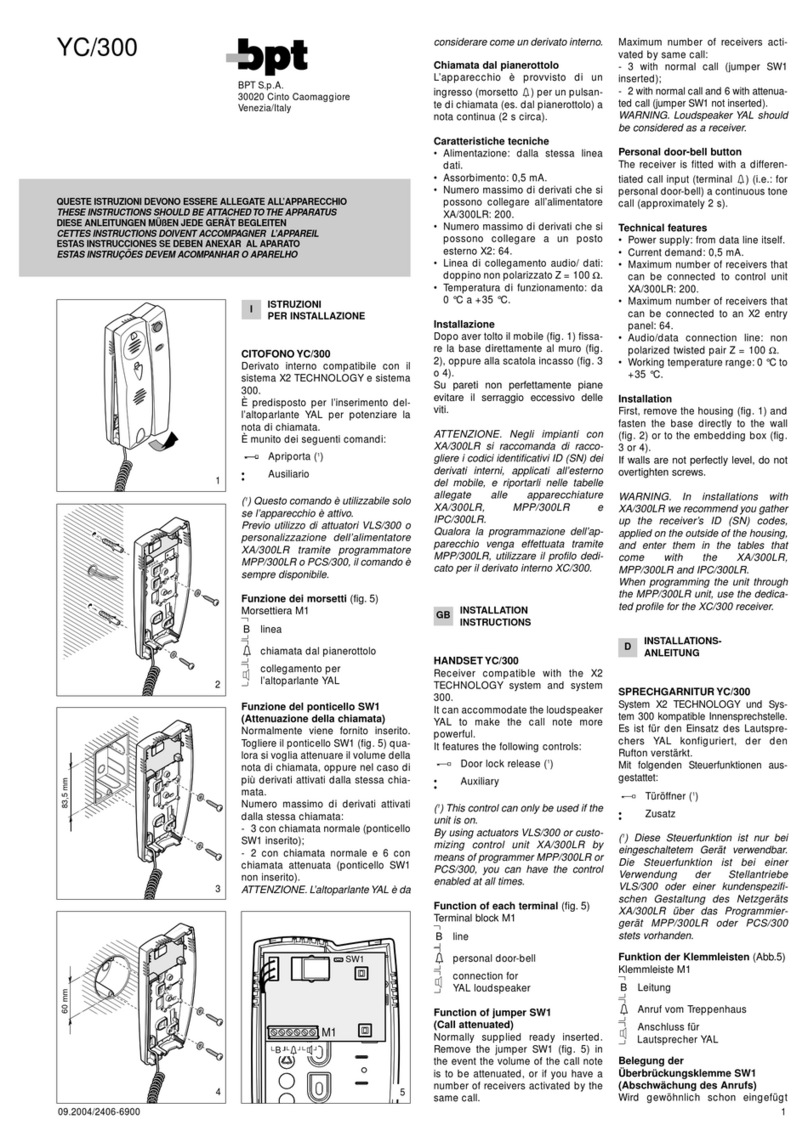
Bpt
Bpt YC/300 installation instructions
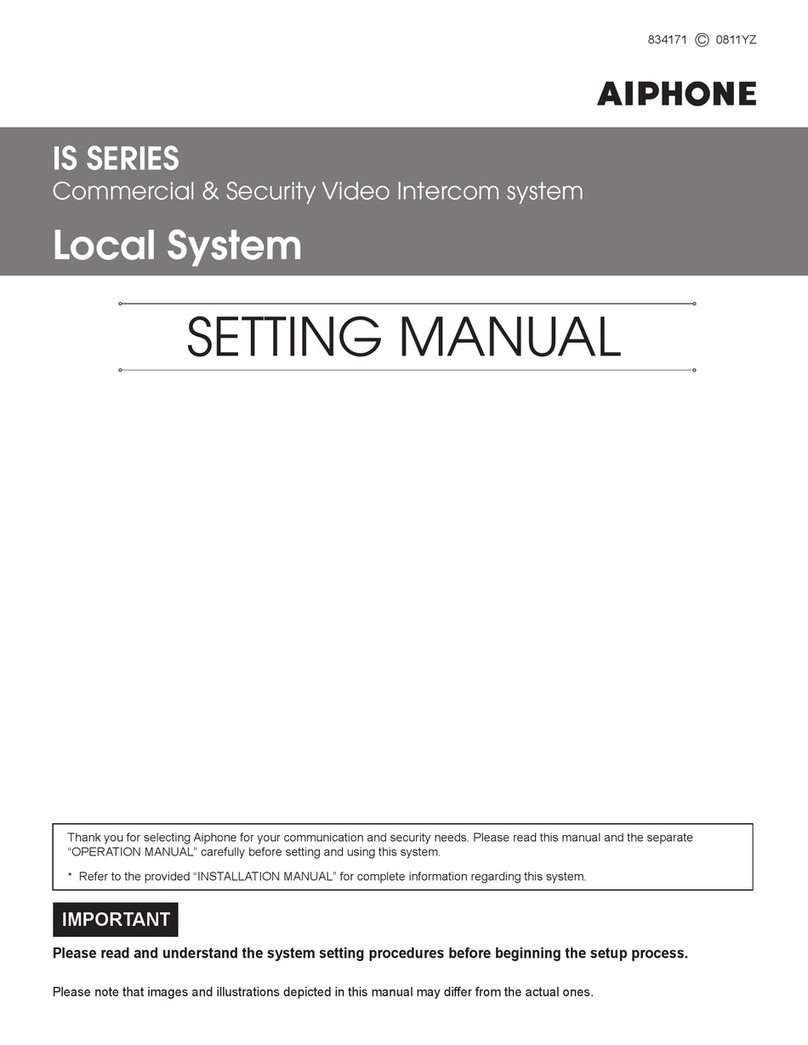
Aiphone
Aiphone IS SERIES Local System Setting manual
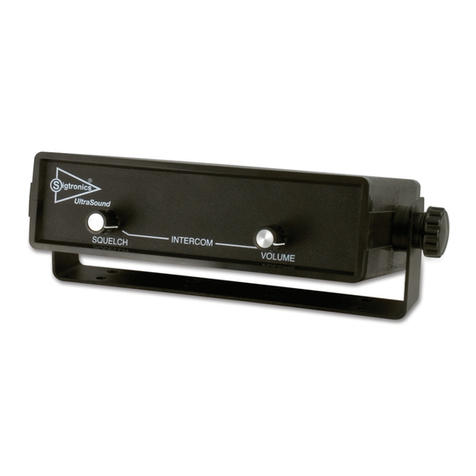
Sigtronics
Sigtronics UltraSound US-LAC4 Installation and operating instructions

KAWNEER
KAWNEER 1686 installation instructions
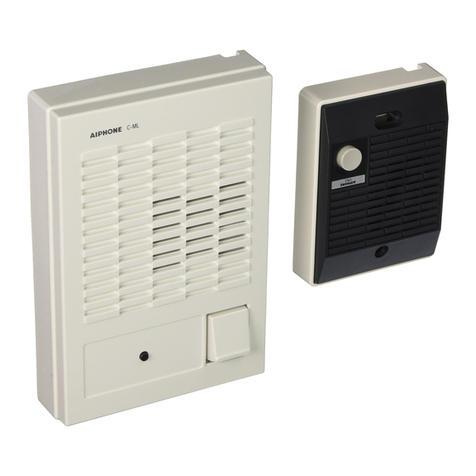
Aiphone
Aiphone CHIME-COM C-123L/A manual
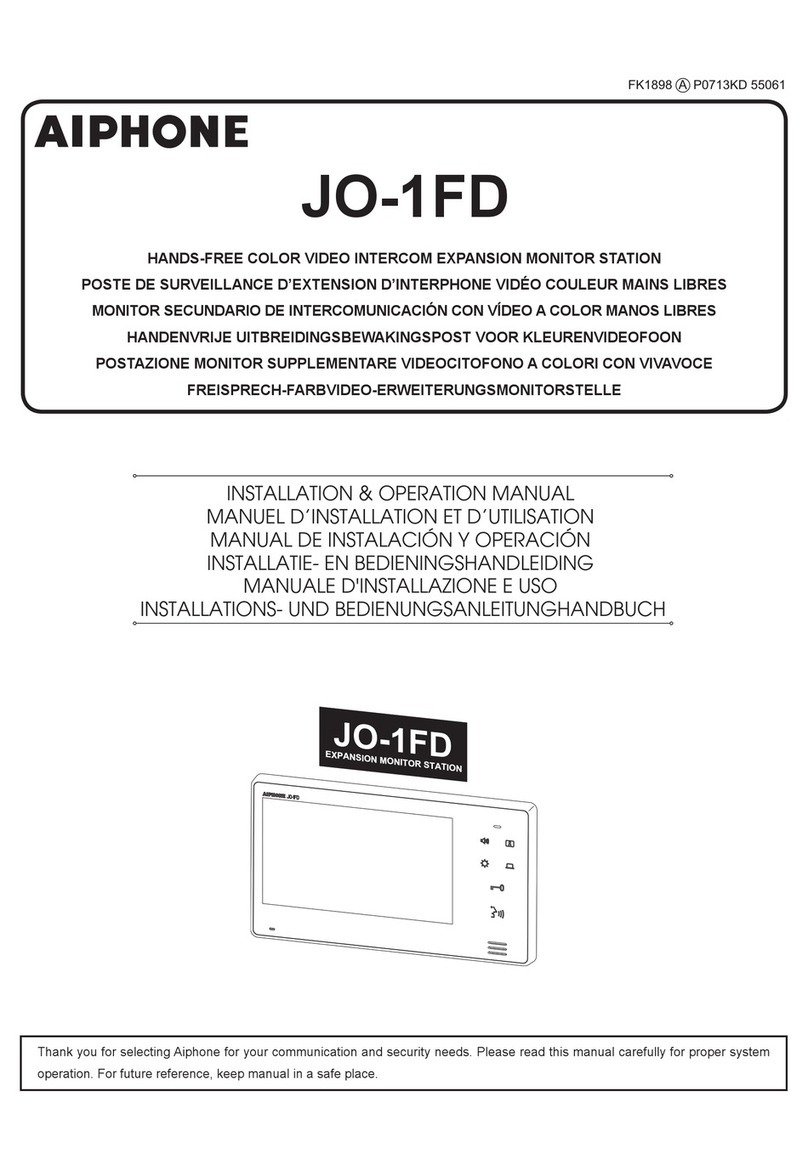
Aiphone
Aiphone JO-1FD Installation & operation manual
